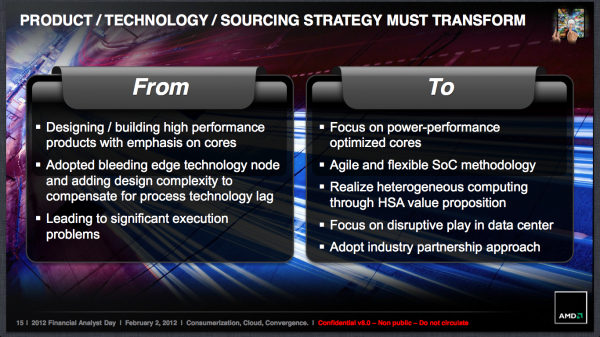Understanding AMD's Roadmap & New Direction
by Anand Lal Shimpi on February 2, 2012 6:16 PM EST- Posted in
- CPUs
- AMD
- Trade Shows
- AMD FAD 2012
ARM & The Future
Thankfully, Rory isn't HPing the company. AMD will continue to build its own x86 CPUs and GCN (and future) GPUs. The difference is that AMD will now consider, where it makes sense, using other architectures. AMD didn't come out and say it, but it's clear that the other ISA under consideration is designed by ARM. In the markets where it makes sense, AMD might deliver an ARM based solution. In others it may deliver an x86 based solution. The choice is up to the market and customer, and AMD is willing to provide either.
What's most interesting is that AMD was very clear about not wanting to be in the smartphone market. It believes, at least today, that the smartphone SoC market is too low margin to make financial sense. With smartphone SoCs selling for under $20 and given how hard it has been for Intel and NVIDIA to break into that market, I don't blame AMD for wanting to sit this one out. However, smartphones have been a huge success for ARM. If AMD is to offer ARM based SoCs coupled with their own CPU/GPU IP in other markets, it's unclear what the reception will be. The flexibility is definitely appreciated and it's a far more defensible position than saying that all future products have to use x86, but simply embracing ARM isn't a guarantee for success.
Rory Read presented a vision of the future where a large, vertically integrated device manufacturer may want to deliver custom silicon for everything from tablets to notebooks to TVs. AMD's goal is to be able to provide silicon to companies like this, while differentiating based on its own internal IP (x86 CPUs, GPU cores). One current example would be Microsoft's Xbox 360. AMD designed much of the silicon for that console, although it's using 3rd party CPU IP. In other words, should a customer want an ARM based solution mated with an AMD GPU, they could have one. If a customer wanted a strange x86/ARM APU, that would be a possibility as well.
AMD did a good job outlining that it would be more agile and flexible, however it didn't outline what specific products we'd see that implement this new architecture agnostic mentality. I suspect AMD's lack of specific examples is a result of the simple fact that the new management team has only been in place for a handful of months. It will take a while to develop outlines for the first products and a clear roadmap going forward. Until then, it's all about executing on the APU, GPU and server CPU fronts.











84 Comments
View All Comments
honsonic - Sunday, February 5, 2012 - link
well its just sad this may lead to intel dominating a certain market and controlling the prices, also developing tech in the future won't be hindered by this.polyzp - Monday, February 6, 2012 - link
We will see awesome competition at the 600-800 dollar range from amd. 17w trinity looks like it will be the 17w king. Quadcore with discrete graphics performance in an ultrathin form factor and crazy good battery life. It will be interesting to see if ivy bridge ulv graphics even comes close.http://AMDFX.blogspot.com
Onslaught2k3 - Tuesday, February 7, 2012 - link
AMD has about until late 2014 to turn things around before Intel is able to go fabless. Once Intel goes fabless they have the opportunity to either cut costs or make even more money by contracting fabrication to TSMC or any other semiconductor firm on a cheaper bill. I honestly DO hope AMD does make a comeback with either excavator or piledriver. Bulldozer certainly dozed off for AMD....wumpus - Saturday, April 14, 2012 - link
Highly competitive GPUs (usually win everything between chipset based to ulta-high end)Uncompetitive CPUs (with the rare competitive fusion chips, and others are often worth the good deals you can get at microcenter).
Zero-content marketing giberish. I don't think anyone can compete with AMD's buzzword/sentence, nor have a chance to compete with them on new "long term plans" that mean absolutely nothing.